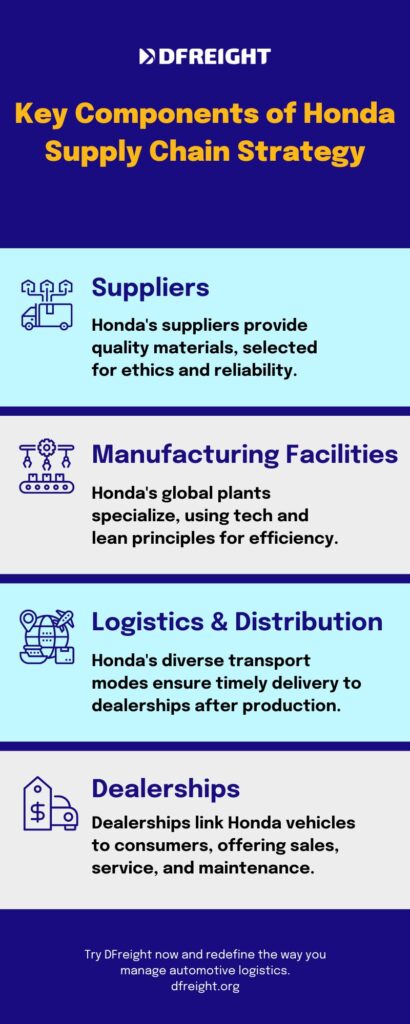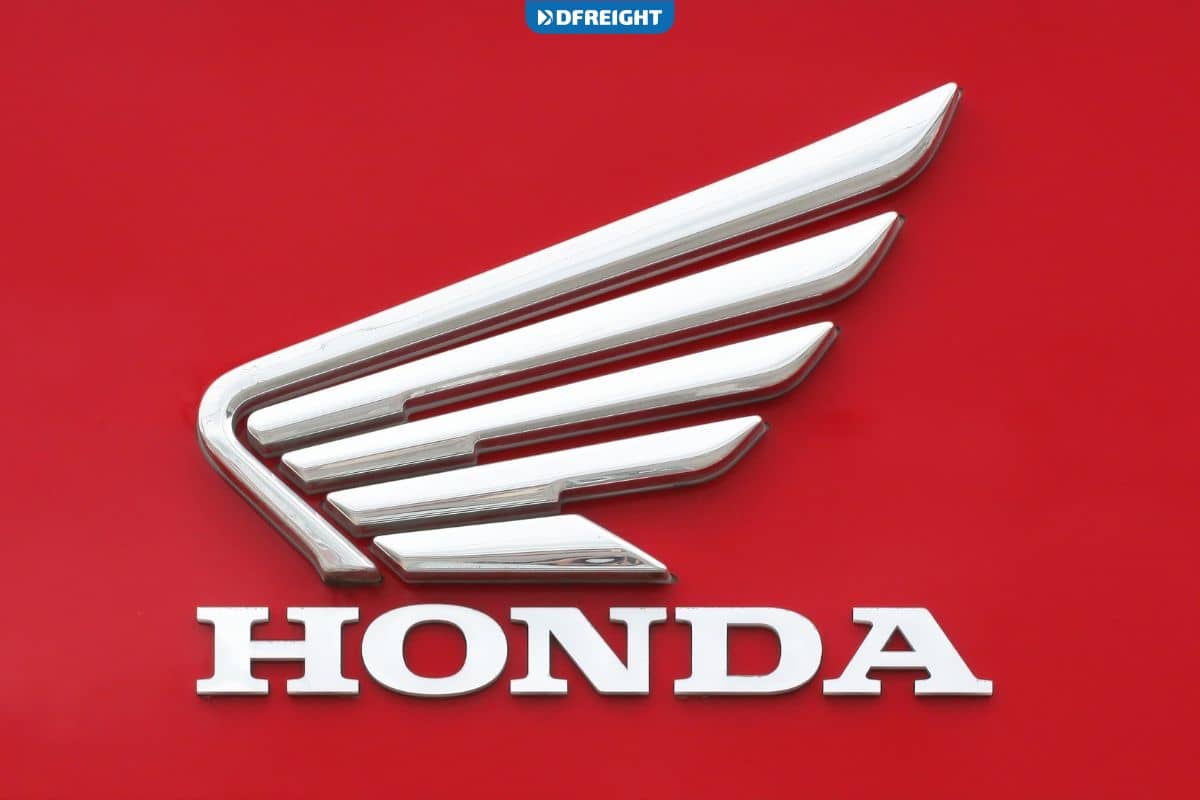In the fast-paced world of automotive manufacturing, few names are as recognizable and respected as Honda. With a legacy spanning decades, Honda has established itself as a global leader in the industry, known for its innovative vehicles and efficient and effective supply chain management. In the case of Honda, the supply chain network extends far beyond the factory floor, encompassing suppliers, manufacturers, distributors, and dealerships worldwide.
Experience the future of freight forwarding with DFreight’s innovative digital platform and mobile app. Shipping cars has never been more efficient and hassle-free. With real-time tracking, streamlined documentation, and a user-friendly interface, DFreight empowers you to take control of your shipments like never before. Join the ranks of businesses that are optimizing their automotive supply chain with DFreight. Don’t miss out on a chance to elevate your shipping experience – try DFreight now and redefine the way you manage automotive logistics.
As we delve into this blog post, we’ll uncover the intricate workings of the Honda supply chain. We’ll explore the strategies, technologies, and practices that Honda employs to ensure its vehicles reach consumers with precision and quality. From supply chain planning and production processes to distribution logistics and sustainability initiatives, every aspect of Honda’s supply chain plays a vital role in maintaining its reputation for excellence.
Table of Contents
Honda Supply Chain Strategy
A meticulously designed and managed supply chain lies at the heart of Honda’s success. The complexity and efficiency of this network are paramount in ensuring that Honda vehicles reach their destinations with precision, quality, and timeliness.
Honda‘s supply chain is a comprehensive ecosystem encompassing multiple stages and stakeholders. It begins with sourcing raw materials and components, extends through manufacturing and assembly processes, and culminates in distributing finished vehicles to dealerships and consumers globally.

Key Components in Honda Supply Chain Strategy:
- Suppliers: Honda’s supply chain begins with its suppliers, who provide raw materials, components, and parts needed for vehicle production. These suppliers are carefully selected based on quality, reliability, and adherence to ethical and environmental standards.
- Manufacturing Facilities: Honda operates manufacturing plants worldwide, specializing in different vehicle models or components. These facilities utilize advanced technologies and lean manufacturing principles to achieve high levels of efficiency and quality.
- Logistics and Distribution: After production, vehicles, and parts are transported via a network of distribution channels. This includes various modes of transportation, such as trucks, trains, ships, and planes, to ensure timely delivery to dealerships and customers.
- Dealerships: Dealerships form the final link in the supply chain, connecting Honda vehicles with consumers. They provide sales, service, and maintenance, thus completing the supply chain cycle.
Supply Chain Planning and Strategy:
Honda’s supply chain success is rooted in careful planning and strategic decision-making. This involves:
- Demand Forecasting: Accurately predicting consumer demand helps Honda optimize production levels and inventory, preventing overstocking or shortages.
- Inventory Management: Honda employs a just-in-time (JIT) inventory approach, where parts and components are ordered only when needed. This reduces storage costs and minimizes waste.
- Collaborative Planning: Honda collaborates closely with its suppliers to align production schedules, ensuring a smooth flow of materials and minimizing production bottlenecks.
Supplier Relationship Management:
- Importance of Strong Supplier Relationships: Honda recognizes suppliers’ critical role in the supply chain. A strong supplier relationship fosters collaboration, innovation, and flexibility, all contributing to a resilient supply chain.
- How Honda Selects and Collaborates with Suppliers: The company employs stringent selection criteria for suppliers, focusing on quality, reliability, and ethical practices. Collaborative efforts between Honda and its suppliers ensure smooth material flows and production processes.
Manufacturing and Production Processes:
- Insight into Honda’s Manufacturing Facilities and Processes: Honda’s manufacturing plants are renowned for their efficiency and flexibility. Each plant specializes in specific vehicle types, allowing optimized production processes tailored to different models.
- Just-in-Time (JIT) Production and Its Impact on Efficiency: Honda’s adoption of the JIT production philosophy minimizes waste by producing vehicles and components only as needed. This lean approach enhances efficiency, reduces costs, and enables quick response to market changes.
Distribution and Logistics:
- Honda’s Distribution Network and Logistics Strategies: Honda’s global distribution network utilizes various modes of transportation, optimizing routes and minimizing transit times. This strategic approach ensures that vehicles and parts reach their destinations promptly.
- Ensuring Timely and Efficient Delivery of Vehicles and Parts: Efficient logistics management is crucial in preventing supply chain disruptions. Honda’s commitment to timely delivery contributes to its reliability and customer satisfaction reputation.
Technology and Innovation:
- Integration of Technology for Real-Time Tracking and Monitoring: Honda’s supply chain leverages advanced technology to monitor real-time shipments, parts, and vehicles. Honda ensures transparency and agility in its operations by using GPS, RFID, and IoT solutions. This real-time tracking capability enables quick responses to disruptions, leading to smoother logistics and enhanced customer satisfaction.
- Role of Data Analytics and Automation in Optimizing the Supply Chain: Data analytics drives Honda’s supply chain optimization efforts. By analyzing consumer preferences, historical sales, and market trends, Honda makes informed production and inventory management decisions. Automation, including robotics, streamlines manufacturing and logistics processes, improving precision and efficiency across the supply chain.
Sustainability and Ethical Practices:
- Honda’s Initiatives towards Sustainable and Ethical Supply Chain Practices: Honda strongly emphasizes sustainability and ethics in its supply chain. The company takes measures to reduce its carbon footprint, embrace renewable energy sources, and implement waste reduction strategies. By promoting responsible sourcing, Honda ensures that the materials used in its products are ethically and sustainably obtained, contributing to a more environmentally conscious supply chain.
- Reduction of Environmental Impact and Promotion of Responsible Sourcing: Beyond its commitment to environmental sustainability, Honda emphasizes responsible sourcing practices. The company collaborates with suppliers that uphold ethical standards and prioritize sustainable extraction and processing of materials. This approach not only supports ethical practices but also contributes to minimizing the environmental impact of the entire supply chain.
DFreight’s Revolution in Automotive Shipping and Supply Chain Management
DFreight is a pioneering digital freight forwarder, offering an online platform and a user-friendly mobile app to revolutionize the shipping industry. Specializing in shipping cars, DFreight redefines the concept of efficiency in the automotive supply chain. With its advanced digital tools, customers can seamlessly manage their shipments, track real-time cargo status, and access all relevant documentation from the convenience of their devices. This streamlined approach simplifies the intricate logistics of shipping vehicles, resulting in cost savings, reduced paperwork, and quicker delivery times.
DFreight’s commitment to leveraging technology for efficient automotive supply chain operations indicates a paradigm shift in the logistics industry, where intuitive digital solutions overcome traditional complexities, ultimately benefiting businesses, consumers, and the environment.

In the previous blogs, we looked into the supply chains of famous and leading companies, which you can read about each of them in the section below.
| Nike | Coca-Cola | Zara |
| Apple | Toyota | L’Oréal |
| Intel | Starbucks | Cisco |
| Amazon | Tesla | KFC |
| Adidas | Nestle | Costco |
| Samsung | Unilever | H&M |
| ADNOC | Schneider Electric | BMW |
| Pepsi | McDonald | Walmart |
| McDonald |
Conclusion
In the intricate world of automotive supply chains, Honda’s approach is a beacon of excellence, demonstrating the art of balancing innovation, sustainability, and efficiency. From the seamless integration of technology to the meticulous management of supplier relationships, Honda’s commitment to continuous improvement is evident.
As we gaze into the future, the automotive industry stands on the cusp of transformation, propelled by trends like electric vehicles, autonomy, and digitalization. As exemplified by Honda, the key to success lies in adaptation and anticipation. By embracing these trends and embodying a resilient supply chain ethos, automotive companies can navigate challenges and forge a path toward a more dynamic, efficient, and sustainable future.
In a landscape defined by change, Honda’s insights into its supply chain offer valuable lessons for businesses across industries, echoing the essential truth that the journey to success begins within the intricacies of the supply chain.
What’s Honda’s secret to supply chain success?
Honda’s supply chain excellence is no accident. It’s a fusion of careful planning, innovative strategies, and cutting-edge tech. Imagine a production line that’s just-in-time, minimizing waste while maximizing efficiency. Picture strong supplier relationships that keep the supply chain moving like a well-choreographed dance. Top it off with real-time tracking for a symphony of timely deliveries and exceptional quality.
What sets Honda’s supply chain strategy apart?
Honda’s supply chain strategy is distinctive due to its emphasis on efficiency, flexibility, and collaboration. The company’s commitment to just-in-time production, strong supplier relationships, and real-time tracking sets it apart in the automotive industry.
What are the future trends in the automotive supply chain?
The automotive supply chain is evolving with trends such as electric vehicles (EVs), autonomous driving technology, and digitalization. EVs require adjustments in supply chains to accommodate new components and charging infrastructure. Autonomous vehicles are reshaping logistics networks. Digital tools, data analytics, and sustainability are becoming key factors in shaping the future automotive supply chain.
How does Honda adapt its strategy to global challenges?
Honda’s supply chain strategy demonstrates adaptability in the face of global challenges. The company’s contingency planning and risk management strategies allow it to respond effectively to disruptions caused by events like natural disasters, geopolitical shifts, and economic fluctuations.
How does Honda prepare for the future in its supply chain strategy?
Honda’s forward-looking strategy anticipates future trends in the automotive industry. Whether it’s electric vehicles, autonomous driving, or digitalization, Honda’s supply chain strategy is poised to adapt and embrace emerging technologies and market shifts.













